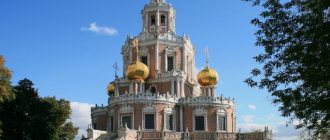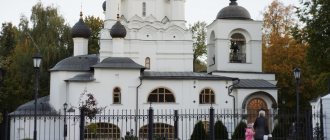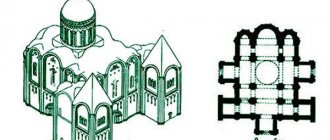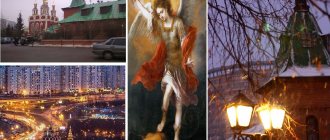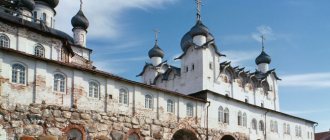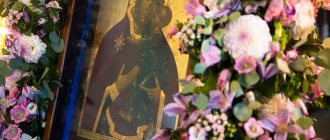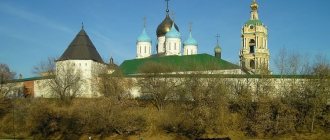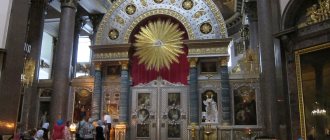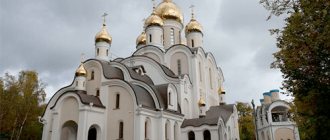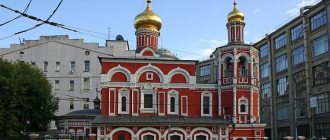Excursions in Vladimir | Booking apartments in Vladimir |
Every tourist who comes to Vladimir strives to get to Bogolyubovo, because it is there that the most beautiful Russian church, a masterpiece of ancient Russian architecture, is located. Any schoolchild knows her image, but not everyone has been to Bogolyubovsky Meadow. Bogolyubovo is located 12 km from the center of Vladimir. Now this is an area of the city of Vladimir, and you can get there by regular public transport, that is, travel will cost you 22 rubles (2018).
How to get to Bogolyubov
Based on the fact that you will most likely live in Vladimir in the center, we will choose Cathedral Square as our starting point. Bus No. 152 will take us from Cathedral Square to the Bogolyubovsky Monastery, and we will use it to return back after our walk to the Intercessions.
It’s interesting to look around on the way: you’re unlikely to wander into these areas of Vladimir on purpose.
And one more piece of advice: it’s best to go to Bogolyubovo and to the veils early in the morning. At 8 am we were already at the bus stop, so we saw the monastery without crowds of tourists, and admired the Intercession alone, but already on the way back along the path in the meadow, organized groups were briskly walking towards us.
Church of the Intercession on the Nerl divine services
Liturgy in the church is celebrated rarely, on the patronal feast day (Protection of the Most Holy Theotokos; October 1/14), as well as on the Lord’s twelve feasts, of which there are only eight:
- Exaltation of the Holy Cross (September 14/27)
- Christmas (December 25/January 7)
- Epiphany of the Lord (January 6/19)
- Presentation of the Lord (February 2/15)
- Entry of the Lord into Jerusalem (last Sunday before Easter)
- Ascension of the Lord (fortieth day after Easter)
- Trinity Day (fiftieth day after Easter)
- Transfiguration of the Lord (August 6/19).
How to get to the Church of the Intercession on the Nerl on your own
Bogolyubovo is 13 kilometers away from Vladimir. By car, leave the city along the M7 highway (to Nizhny Novgorod). After passing the wall of the Bogolyubsky Monastery (remains on the right hand), you need to turn right at the traffic light. The road goes sharply down and leads to the Bogolyubovo railway station. You will have to leave your car in the parking lot next to it and make the further journey on foot - along a stone-paved path through Bogolyubovsky Meadow (about one and a half kilometers).
You can also get to Bogolyubov by bus: routes No. 18 and No. 152 go here from Vladimir.
GPS coordinates: 56.19625,40.56135
How to get to the Church of the Intercession on the Nerl? Is there parking nearby?
How to get to the Church of the Intercession on the Nerl? Is there parking nearby?
The Church of the Intercession on the Nerl, built in the 12th century, is located near the village of Bogolyubovo, Vladimir region. Since the small church is included in the list of Cultural Heritage of Russia, the entire area surrounding the monument is located in a protected area. For this reason, any movement by vehicle in the area of the temple itself is prohibited by local law. There are two ways to get to the shrine. The first method involves stopping in the village of Bogolyubovo, paying for a paid parking space at the railway station and walking along a dedicated paved path to the temple itself. You will have to walk about 1.5 kilometers, for which you need to be prepared. Another method is suitable for summer time. Personal transport can be left completely free of charge on the territory of the Bogolyubsky Monastery, and either walk to the temple in the same way, or use draft transport. For Bogolyubov, such a specific type of transport is a horse-drawn cart, on which guests and pilgrims are taken not only to the temple, but also back.
Church/Temple of the Intercession on the Nerl" is located at the address: Vladimir region, Suzdal district, Bogolyubovo village. The temple is located in the middle of a field, and there is no road to it; all traffic is prohibited. Therefore, everyone who is going to visit this famous monument of Dnieper Russian architecture needs to get (by bus, train or car) to the Bogolyubovo station and then travel 1.5 km along a paved path on foot or pay and ride in a horse-drawn cart. You can leave your car in a paid parking lot near the Bogolyubovo railway station or in a free parking lot near the entrance to the Bogolyubsky Monastery.
If you set out to get acquainted with the historical sights of Vladimir and its environs, then of course the Bogolyubsky Monastery, which is located a few kilometers from Vladimir (Bogolyubovo village, old road to Nizhny Novgorod), will be on your list. Well, if you are lucky enough to get to the monastery, sacrifice an hour of your precious time and visit the Church of the Intercession on the Nerl. True, the path to the church is quite long (to be more precise, from Bogolyubovo station to the church you have to cover 1.3 km (one way) over rough terrain, through flooded meadows (therefore, during a flood, you can only get there using some kind of some kind of watercraft). One local old-timer suggested that we save time and shorten our walk in the fresh air by 500 meters. Taking him “hostage”, we, unlike other tourists, drove up immediately to the road bridge over the Nerl (it is located at the exit from the village of Bogolyubovo (if you are coming from Vladimir) and leaving the M7 highway we went down the dirt road to the river. As the old-timer assured, if you pass under the railway bridge, then the church is just a stone's throw away.
Holy Bogolyubsky Convent
The Holy Bogolyubsky Convent was founded at the end of the 12th century. However, only buildings erected in the 18th-19th centuries have survived to this day. The monastery was built in pseudo-Russian style. According to legend, the monastery, around which the settlement later grew, was founded by Andrei Bogolyubsky when the prince was transporting the icon of the Mother of God from Vladimir to Rostov. 10 km from Vladimir the horses stopped, and no way could get them to go further. We spent the night at this place. That night the appearance of the Mother of God took place, and on this very spot a monastery was founded.
The monastery has survived a lot, however, the earthen ramparts, ditches and lower parts of the walls and pillars of the white stone fortifications have partially survived to this day. The remains of the castle have been preserved: a passage on semicircular arches and a square white-stone tower with a spiral staircase, as well as the basement of the Church of the Nativity of the Virgin Mary (1158-65), on which a tiered church in the Baroque style was erected in 1751. Also preserved are the Gate Assumption Church-bell tower and cells, which were built in the 19th century, as well as the Bogolyubsky Cathedral, built in the Byzantine-Russian style, designed by the architect K. A. Ton in 1866.
Church of the Intercession on the Nerl
Russia, Vladimir region, village Bogolyubovo
From 8 am to 6 pm daily
The Church of the Intercession on the Nerl is a white-stone temple of the 12th century, rightfully considered a work of art by ancient Russian architects. It is located in the Vladimir region, one and a half kilometers from the village of Bogolyubovo. Currently it is an active church. On days free from services and sacraments, you can visit it as a museum.
The small, modest, lonely temple is known not only in Russia, but also far beyond its borders. This attention is caused not only by its unique historical value, but also by its unusual location.
The Church of the Intercession on the Nerl was built in the middle of a water meadow, at the confluence of the Nerl River and the Klyazma. Now the river flows a little lower, but the location of the temple is the same. During the spring flood, the meadow surrounding the church is flooded with water, and it can only be reached by boat. This time to visit is considered the best, since nature itself creates a unique picturesque landscape.
Interior design
When designing the interior space, the architects also sought to emphasize the upward direction. The vaults are supported by four pillars, which slightly taper towards the top, due to which the height of the building visually increases.
Previously, on the dome there was an image of Christ Pantocrator with archangels and seraphim, the floor was covered with colored majolica slabs, and the walls were painted with frescoes. The paintings were destroyed during the renovation of the church in 1877.
The Church of the Intercession on the Nerl is a masterpiece of world architecture; it, like a warrior in a silver helmet and a white stone shirt, stands on a small hillock.
In spring, it looks like a swan towering above the surface of the waters, and in winter, like a monument, it looks out from the snowdrifts. With the arrival of summer, the light and sparkling white church, like a candle, rises among the greenery of a vast water meadow.
The Church of the Intercession on the Nerl is assigned to the Bogolyubov Monastery. After restoration, it acquired almost its original appearance and is currently used jointly by the church and the museum-reserve.
Story
Construction was completed during the time of Prince Andrei Bogolyubsky in a record time for those times - one summer. One of the most popular versions of its creation is the construction in memory of the son of Prince Andrei, Izyaslav, who died during the battle of the Vladimir army with the Bulgarians.
This is the first church in Rus' dedicated to the Feast of the Intercession of the Blessed Virgin Mary. Even during the time of Andrei Bogolyubsky, there was a monastery next to the temple, but it was later abolished. In the 18th century, there were attempts to dismantle the masonry due to the low profitability of the church, but, fortunately, this was not possible. In the 19th century, during restoration, the interior paintings were destroyed. In 1922, the temple was included in the UNESCO World Heritage List.
Swan Temple floating on the waves of time
Like a candle, the Church of the Intercession on the Nerl rises on a low hill. The construction technology used by ancient architects made it possible to avoid treacherous spring floods: a regular strip foundation was laid at a depth of 1.6 m, and a bulk hill 3.7 m high was erected above it.
The Church of the Intercession on the Nerl is distinguished by its harmony of proportions, graceful silhouette and complete fusion with the surrounding landscapes. In the spring, the single-domed white-stone temple, like a swan, rises above the waters of the Nerlin oxbow; in winter, the monument seems to grow out of snowdrifts; in summer, out of the thick grass of flooded meadows. The walls of the temple are decorated with white stone carvings, traditional for Vladimir-Suzdal architecture. The central figure in the composition of all three facades is King David the Psalmist, seated on the throne. The king is surrounded by figures of birds, lions and three female masks with hair braided. Reliefs of girls' faces also surround the side parts of the facades. These masks, personifying the Virgin Mary, are characteristic of all Vladimir churches of that era.
According to historians, initially the Church of the Intercession on the Nerl was surrounded by a light covered gallery, decorated with images of carved griffins and other mythical animals. Once upon a time, the walls of the church were covered with colorful frescoes, but they were completely lost in 1877 during the next “renovation” of the temple. The church itself miraculously survived. And the threat came not from militant atheists, but from Orthodox clergy. In 1784, the abbot of the Bogolyubsky Monastery received permission from the Bishop of Vladimir to dismantle the temple into stone. The materials received were intended for the construction of a new bell tower, but the ancient temple was saved by a prosaic situation - the abbot did not agree on the price for dismantling with the contractors.
The ascetic appearance of the Church of the Intercession on the Nerl determined its royal beauty and strength. There are no gilded iconostases or rich paintings inside. But the unknown architects achieved what they set out to achieve - they embodied in stone the idea of the superiority of the spiritual over the material, which is the core of any religion. And this is probably why the creation of ancient Russian masters rightfully received worldwide recognition. In 1992, the Church of the Intercession on the Nerl, along with other temples of ancient Russian architecture, was included in the UNESCO World Heritage List
under the collective title “White stone monuments of Vladimir and Suzdal”.
Attraction rating:
Rating 4.07 [45 vote(s)]
| ← RUSSIA | VLADIMIR REGION | EUROPE → |
What does the temple look like, what's inside?
The hill on which the Church of the Intercession on the Nerl stands is artificially created. To ensure that the building did not go under water, a five-meter foundation was built, on which the cross-domed church still stands. The church has four pillars and one dome, and is decorated on the outside with unusual carved reliefs.
The size of the main building is approximately 7 by 8 meters, taking into account the sufficient thickness of the walls (at least a meter), the internal space is quite small. All you will see when entering the temple are white walls, several frescoes (imported) and a church bench.
The harmony and completeness of the appearance of Andrei Bogolyubsky’s white stone creation attracts thousands of tourists to it every year, who are not afraid to walk along the meadow path for about one and a half kilometers.
When and why was the church built
There were several reasons for the construction of the church. They are beautifully presented by N.N. Voronin in the study mentioned above.
“The temple at the mouth of the Nerl, as legend tells, was a solemn monument in memory of the victorious campaign of the Vladimir regiments against the Bulgarians in 1164, and the stone for its construction was allegedly brought here as a kind of indemnity by the defeated Bulgarians.
At the same time, the temple was a monument to Andrei's son Izyaslav , who paid for this victory with his life.
The temple was dedicated to a new holiday - the Intercession of the Virgin Mary , established by the Vladimir prince and clergy without the consent of the Kiev metropolitan and patriarch. This holiday spoke of the special patronage of the “Queen of Heaven” to the “true kings,” the Vladimir dynasty and the Vladimir land.”
N.N. Voronin “Vladimir. Bogolyubovo. Suzdal. Yuriev-Polsky"
A little clarification is in order here . In August 1164, Andrei Bogolyubsky won a battle with the Volga Bulgars. However, during this battle, Andrei Bogolyubsky's son Izyaslav was seriously wounded, who soon died from his wounds. And the prince built a temple, which stood like a memorial candle in memory of his untimely deceased son.
The temple was erected by the architects of Andrei Bogolyubsky “in one summer,” that is, in one construction season in 1165, immediately after the campaign against Volga Bulgaria. According to chronicles, a whole team of craftsmen worked on the construction of the temple.
How to get to the Church of the Intercession on the Nerl
The temple is often an obligatory element of routes around the cities of the Golden Ring, including a visit to the city of Vladimir. Tourists are usually dropped off at the railway station, from where they walk across the meadow.
If you want to get to the Church of the Intercession on the Nerl on your own, you need to get to the village of Bogolyubovo (10 km northwest of Vladimir), and also walk from the railway station (the top of the church is always visible from the bridge over the railway).
Architectural and cultural landmarks
If you make a brief description of the Church of the Intercession on the Nerl, it will sound like this: a single-domed white-stone three-apse church with narrow window openings, the facades of which are decorated with carved bas-reliefs. True, you cannot see the original chic of the temple now: it was surrounded by a covered gallery up to 5.5 m high. The fact that it existed is evidenced by archaeological excavations and a door high in the wall (on the right side of the temple). Here a staircase descended from the gallery, intended for the princely family.
Outside, on the three facades, you can count 19 relief images with unusual and symbolic subjects: among them are female portraits with braids, King David, lions, griffins, doves and a leopard. It is clear why the lion is used in the bas-reliefs - it is not only a common symbol, but also signified the founder himself, Prince Bogolyubsky. This personal symbol has been passed down by the princes of the Vladimir region for centuries (today it is placed on the coat of arms of Vladimir). Doves refer us to the Holy Spirit, but many female heads may well mean the Mother of God, whose name the temple bears. There is even a griffin carrying a doe on the façade: whether this is a sign of Christ, or something else, is unclear. The bas-reliefs have barely survived, and it is impossible to explain why the architects depicted some scenes on the temple.
